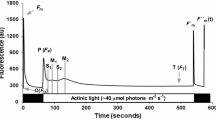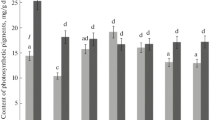Abstract
Plants respond to growth under different environmental conditions by adjusting the composition of the photosynthetic apparatus. To investigate the consequences of the acclimation strategies adopted by Arabidopsis thaliana, we have assessed the functioning of the photosynthetic apparatus in plants with very different chloroplast compositions. Using chlorophyll fluorescence analysis, we have determined the efficiency of, and capacity for, electron transport, assessed the ability to undergo state transitions, and measured non-photochemical quenching over a range of actinic irradiances followed by its resolution into fast- and slow-relaxing components; parallel measurements of leaf carotenoid composition were also carried out. The data clearly show that acclimation serves to maintain the electron transport chain in an oxidised state, ensuring efficient photochemistry. Furthermore, plants grown in high light have a greater capacity for energy-dependent feedback de-excitation, but this is not correlated with xanthophyll cycle pigment levels or de-epoxidation state. Surprisingly, even plants with very low levels of light-harvesting complexes were able to undergo state transitions. We also show that apparent discrepancies between chloroplast composition and photosynthetic function can be attributed to varying degrees of light penetration through the leaf. Thus, leaf chlorophyll content is an important factor influencing acclimation within the leaf.





Similar content being viewed by others
References
Allen JF, Forsberg J (2001) Molecular recognition in thylakoid structure and function. Trends Plant Sci 6:317–326
Anderson JM, Chow WS, Park YI (1995) The grand design of photosynthesis: acclimation of the photosynthetic apparatus to environmental cues. Photosynth Res 46:129–139
Andersson J, Wentworth M, Walters RG, Howard CA, Ruban AV, Horton P, Jansson S (2003) Absence of the Lhcb1 and Lhcb2 proteins of the light-harvesting complex of photosystem II—effects on photosynthesis, grana stacking and fitness. Plant J 35:350–361
Bailey S, Walters RG, Jansson S, Horton P (2001) Acclimation of Arabidopsis thaliana to the light environment: the existence of separate low light and high light responses. Planta 213:794–801
Ballaré CL (1999) Keeping up with the neighbours: phytochrome sensing and other signalling mechanisms. Trends Plant Sci 4:201
Bilger W, Björkman O (1990) Role of the xanthophyll cycle in photoprotection elucidated by measurements of light-induced absorbency changes, fluorescence and photosynthesis in leaves of Hedera canariensis. Photosynth Res 25:173–185
Boekema EJ, van Roon H, Calkoen F, Bassi R, Dekker JP (1999) Multiple types of association of photosystem II and its light-harvesting antenna in partially solubilized photosystem II membranes. Biochemistry 38:2233–2239
Brugnoli E, Cona A, Lauteri M (1994) Xanthophyll cycle components and capacity for nonradiative energy-dissipation in sun and shade leaves of Ligustrum ovalifolium exposed to conditions limiting photosynthesis. Photosynth Res 41:451–463
Chow WS, Melis A, Anderson JM (1990) Adjustments of photosystem stoichiometry in chloroplasts improve the quantum efficiency of photosynthesis. Proc Natl Acad Sci USA 87:7502–7506
Davison PA, Hunter CN, Horton P (2002) Overexpression of beta-carotene hydroxylase enhances stress tolerance in Arabidopsis. Nature 418:203–206
Demmig-Adams B, Adams WW (1994) Capacity for energy-dissipation in the pigment bed in leaves with different xanthophyll cycle pools. Austr J Plant Physiol 21:575–588
Evans JR, Vogelmann TC (2003) Profiles of C14 fixation through spinach leaves in relation to light absorption and photosynthetic capacity. Plant Cell Environ 26:547–560
Genty B, Briantais JM, Baker NR (1989) The relationship between the quantum yield of photosynthetic electron-transport and quenching of chlorophyll fluorescence. Biochim Biophys Acta 990:87–92
Gray GR, Savitch LV, Ivanov AC, Huner NPA (1996) Photosystem II excitation pressure and development of resistance to photoinhibition. 2. Adjustment of photosynthetic capacity in winter wheat and winter rye. Plant Physiol 110:61–71
Havaux M, Niyogi KK (1999) The violaxanthin cycle protects plants from photooxidative damage by more than one mechanism. Proc Natl Acad Sci USA 96:8762–8767
Horton P, Ruban AV, Walters RG (1996) Regulation of light harvesting in green plants. Annu Rev Plant Physiol Plant Mol Biol 47:655–684
Huner NPA, Oquist G, Sarhan F (1998) Energy balance and acclimation to light and cold. Trends Plant Sci 3:224–230
Jahns P, Miehe B (1996) Kinetic correlation of recovery from photoinhibition and zeaxanthin epoxidation. Planta 198:202–210
Johnson GN, Young AJ, Scholes JD, Horton P (1993) The dissipation of excess excitation energy in British plant species. Plant Cell Environ 16:673–679
Kooten O van, Snel JFH (1990) The use of chlorophyll fluorescence nomenclature in plant stress physiology. Photosynth Res 25:147–150
Leong TY, Anderson JM (1984) Adaptation of the thylakoid membranes of pea chloroplasts to light intensities. 1. Study on the distribution of chlorophyll-protein complexes. Photosynth Res 5:105–115
Li XP, Muller-Moule P, Gilmore AM, Niyogi KK (2002) PsbS-dependent enhancement of feedback de-excitation protects photosystem II from photoinhibition. Proc Natl Acad Sci USA 99:15222–15227
Maxwell DP, Falk S, Trick CG, Huner NPA (1994) Growth at low temperature mimics high light acclimation in Chlorella vulgaris. Plant Physiol 105:535–543
Maxwell DP, Laudenbach DE, Huner NPA (1995) Redox regulation of light-harvesting complex II and cab messenger-RNA abundance in Dunaliella salina. Plant Physiol 109:787–795
Murchie EH, Horton P (1997) Acclimation of photosynthesis to irradiance and spectral quality in British plant species: chlorophyll content, photosynthetic capacity and habitat preference. Plant Cell Environ 20:438–448
Murchie EH, Yang JC, Hubbart S, Horton P, Peng SB (2002) Are there associations between grain-filling rate and photosynthesis in the flag leaves of field-grown rice? J Exp Bot 53:2217–2224
Neubauer C, Yamamoto HY (1992) Mehler-peroxidase reaction mediates zeaxanthin formation and zeaxanthin-related fluorescence quenching in intact chloroplasts. Plant Physiol 99:1354–1361
Park YI, Chow WS, Anderson JM, Hurry VM (1996) Differential susceptibility of photosystem II to light stress in light-acclimated pea leaves depends on the capacity for photochemical and non-radiative dissipation of light. Plant Sci 115:137–149
Porra RJ, Thompson WA, Kriedemann PE (1989) Determination of accurate extinction coefficients and simultaneous equations for assaying chlorophyll a and chlorophyll b extracted with 4 different solvents—verification of the concentration of chlorophyll standards by atomic-absorption spectroscopy. Biochim Biophys Acta 975:384–394
Rizhsky L, Hallak-Herr E, Van Breusegem F, Rachmilevitch S, Barr JE, Rodermel S, Inze D, Mittler R (2002) Double antisense plants lacking ascorbate peroxidase and catalase are less sensitive to oxidative stress than single antisense plants lacking ascorbate peroxidase or catalase. Plant J 32:329–342
Ruban AV, Young AJ, Pascal AA, Horton P (1994) The effects of illumination on the xanthophyll composition of the photosystem II light-harvesting complexes of spinach thylakoid membranes. Plant Physiol 104:227–234
Savitch LV, Massacci A, Gray GR, Huner NPA (2000) Acclimation to low temperature or high light mitigates sensitivity to photoinhibition: roles of the Calvin cycle and the Mehler reaction. Austr J Plant Physiol 27:253–264
Seemann JR, Sharkey TD, Wang JL, Osmond CB (1987) Environmental effects on photosynthesis, nitrogen-use efficiency, and metabolite pools in leaves of sun and shade plants. Plant Physiol 84:796–802
Torre WR de la, Burkey KO (1990) Acclimation of barley to changes in light-intensity—photosynthetic electron-transport activity and components. Photosynth Res 24:127–136
Vogelmann TC, Evans JR (2002) Profiles of light absorption and chlorophyll within spinach leaves from chlorophyll fluorescence. Plant Cell Environ 25:1313–1323
Walters RG, Horton P (1991) Resolution of components of nonphotochemical chlorophyll fluorescence quenching in barley leaves. Photosynth Res 27:121–133
Walters RG, Horton P (1994) Acclimation of Arabidopsis thaliana to the light environment—changes in composition of the photosynthetic apparatus. Planta 195:248–256
Walters RG, Horton P (1999) Structural and functional heterogeneity in the major light-harvesting complexes of higher plants. Photosynth Res 61:77–89
Walters RG, Rogers JJM, Shephard F, Horton P (1999) Acclimation of Arabidopsis thaliana to the light environment: the role of photoreceptors. Planta 209:517–527
Author information
Authors and Affiliations
Corresponding author
Rights and permissions
About this article
Cite this article
Bailey, S., Horton, P. & Walters, R.G. Acclimation of Arabidopsis thaliana to the light environment: the relationship between photosynthetic function and chloroplast composition. Planta 218, 793–802 (2004). https://doi.org/10.1007/s00425-003-1158-5
Received:
Accepted:
Published:
Issue Date:
DOI: https://doi.org/10.1007/s00425-003-1158-5




